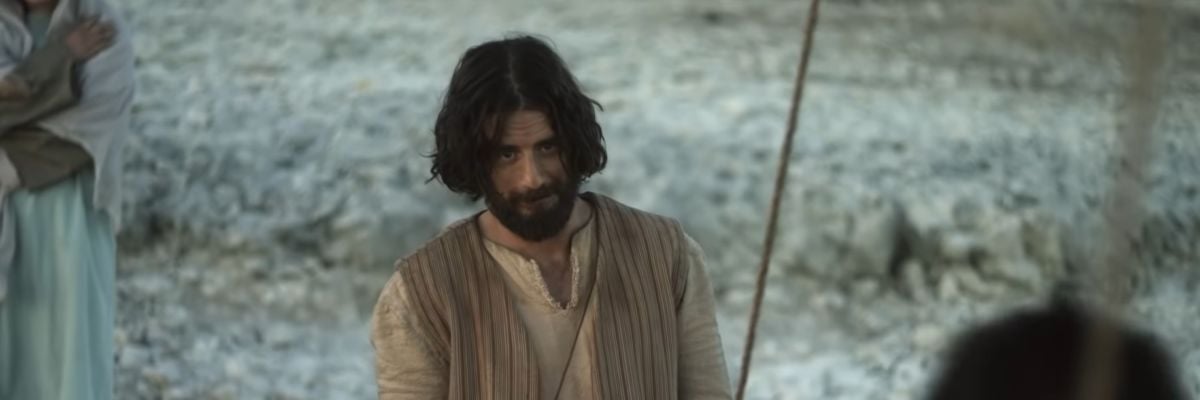
Just about two months ago, I watched the existing episodes of Dallas Jenkins’s The Chosen.
Now, I am not too keen on most of the films out there about Jesus. There are only two that I liked to some extent (I’ll leave these out, but you might figure out which ones they are as you read this article), but I started watching The Chosen in the following way.
My abbey of Norbertine canons is easily recognized as a very conservative place. We have lots of Latin and chant, we study St. Augustine and St. Thomas with the interest of disciples of teachers of great authority. Generally, our tastes do not run in the direction of films on the Savior put out by Evangelicals—except in the case of this series.
I was in our computer room and heard a discussion of The Chosen between one priest confrere of mine and two other priest confreres. Now, the former, let’s call him Fr. X, has very strong opinions about movies, and he enjoys them very much, and he doesn’t like second-rate, “cheesy” Christian films. He spoke of how wonderful The Chosen was. I had never heard of it. Then the other two, Frs. Y and Z, told of their being moved to tears by the episodes they had seen and related that several other confreres had had the same experience. Among these, all but one regularly, practically daily, celebrate the more ancient form of the Mass in Latin. All are careful disciples of St. Thomas Aquinas. They are definitely of the “high and dry” school, as orthodox as they come.
Well, this subjective impression—before, I never would have thought of Fr. Z being moved to tears about anything—persuaded me that I ought to watch the episodes, and so I began. The result? I had the same impressions as the others, and I have looked forward to the new episodes as they come out, including this last Tuesday’s much awaited airing of Season 2, episode 4, as lovely as all the others.
Before this experience, I would have cautioned about the film medium as being insufficiently iconographic or liturgical in its form. This is a critique of movies about Christ often found among the more conservative of the Eastern Orthodox, for example. There is something to this reservation, since there is no doubt that the liturgically proclaimed scriptures and the power of the holy sacraments, and the Church’s sound traditions in the honor due to sacred images, take priority over live performances on stage or cinema or in musical cantatas. These former are necessary and obligatory for all Catholics, but the Church has never required attendance or participation in sacred drama.
Even so, we Catholics invented the live, in-motion drama, presenting the mysteries of salvation. Already, as early as the fourth century, there were hints of sacred plays and performances, and in the Middle Ages, these became a practically universal custom, at least in the Latin-rite Church. The mystery or miracle play accompanied the greater feasts of the year, especially in Passiontide and at Corpus Christi. The most famous of these is the Oberammergau Passion Play, which dates to the Baroque period and is still put on every ten years, drawing many people from all over the world. The last century saw the publication and revival in England of the medieval plays in several places, like Coventry. These plays had humorous interludes and were extremely entertaining with a tone solemn and devout but also warm and human.
We are used to these allowances in sacred art. Are there any two identical paintings of the nativity of the Lord? Hardly. Even in icons there are differences of style, and beyond that, the same event is depicted with characters in the style and dress of various times and regions. The true, historical event is dressed up in the manner of later times, and no one sees this as an abuse or spiritually unhelpful.
In addition, there are the various mystics, usually women, who narrated their own insights and grace-filled imagination of the events of the gospels, especially the infancy and the passion of the Savior. We read these with interest because even though they differ widely among themselves, they convey the wisdom and insight of the Holy Spirit working with their loving imagination. For example, St. Bridget of Sweden, Ven. Mary of Agreda, and Bl. Anne Catherine Emmerich are all different in the many concrete details they relate. So there is no prohibition of adding back-stories and details to the gospel story, as long as it is not misrepresented. Here, it is not—so far, at least, since the series will go on for some seasons.
Thus it is that our only lively concerns about a film production on the gospel narratives are two. First, the presentation must be orthodox—that is, does not rationalize or contradict the gospel narrative, as, for example, in Scorsese’s film version of Kazantzakis’s Last Temptation of Christ. This orthodoxy is beautifully shown in Pasolini’s The Gospel According to Matthew, with a minimum of dramatic filling-out of the sparse Gospel accounts, and in Gibson’s The Passion of the Christ, which did use freely some of the details of Blessed Anne Catherine’s meditations. Second, the film must be good art—that is, it must be done with skill and fine dialogue. So many religious films can be lethally smarmy or third-rate. I name no names, since I don’t want to distract the reader who may have other opinions, but let’s just say that the difference would be like that between an icon, a fresco by Blessed Angelico, or a Murillo Madonna and a mass-produced holy card. I think we all understand the difference.
The other two films I have just mentioned meet both these tests, even though they have very different affective and artistic styles.
I think The Chosen meets these tests also, so far, both as for the orthodoxy (with a significant exception I will address in a moment) and certainly for the really professional and serious artistic skill with which it is acted.
As for its orthodoxy, Christ is clearly divine, the literal fulfillment of Old Testament prophecy, with gifts of clear knowledge of the Godhead and of his creatures, especially human hearts, possessing power to work real miracles and to expel real demons, and who is fully conscious of his identity from childhood on, while displaying a genuine human and manly personality, capable of real human affection and true humility. In addition, Jonathan Roumie, who beautifully plays the role of Jesus, is a Catholic, a devout one, who was raised Greek Orthodox. In interviews he professes his belief in the centrality of the sacraments. This is a Jesus we can accept easily!
But Jesus is also the Son of a Virgin Mother. This is clear in the film in the case of virginity taken in the moral sense that Christ was conceived without human intercourse. Yet Catholic tradition also insists on Our Lady’s physical virginity, which requires a miraculous birth, with his coming forth from her womb with the seal remaining intact, displaying the power which he also displayed in his risen body through the unmoved stone and the doors of the upper room. On this point the little Christmas segment that was put out in promotion of the series is off base. It shows Our Lady undergoing the pains of birth, a rather unseemly thing, and contrary to our belief, reiterated in the Catechism of the Catholic Church and in the catechesis of St. John Paul II. These are simply the most recent pronouncements; in addition, there is the whole of Catholic tradition. There are the Fathers, the Eastern liturgies, the Christmas hymns of the Roman Liturgy of the Hours, the Roman Catechism of the Council of Trent, and numerous other testimonies from tradition. Notably, there is a statement in the postconciliar liturgy. In one of the prefaces of the votive Masses of the Blessed Virgin Mary at the Foot of the Cross, approved by St. John Paul, we read, “She who had given him birth without the pains of childbirth was to endure the greatest of pains in bringing forth to new life the family of your Church.”
I belabor this point since there are many otherwise orthodox Catholics, priests and laity, who are unaware that this is not just a pious opinion, but an ordinary teaching in the Church’s exposition of the creed as found in her two official catechisms. Even the reformers Calvin and Luther would never have questioned this belief; both professed Our Lady’s perpetual virginity. Even so, if you watch the series as it is, the childbirth scene is not among the episodes, so you can avoid it just by not watching the Christmas teaser.
Here, too, is something to watch out for in future episodes: will they present the current (but not classical, reformation) teaching among Protestants that Our Lady had other children by St. Joseph? That’s a pitfall that I hope the artistic crew and scriptwriters don’t fall into, but it remains to be seen.
As for the sacraments, and the primacy of Peter, so far the episodes are clear. There are direct and indirect references to baptism and the holy Eucharist throughout. When the little children, in a charming episode, ask the Lord what foods he likes best, he says, “I especially like bread.”
I think the director and writers are sensitive to their Catholic audience, even though they are Evangelicals, and they consult Catholic priests along with their own pastors, and a Messianic Jewish rabbi.
Now, there is one other thing that is neither precisely doctrinal or artistic. Each age in Christian art, as I mentioned earlier, has projected some of its own visual experience and behavior into the gospel story. This is normal. So also in The Chosen, the rapport between the Lord and his apostles is affected by the easy relations modern people have with authority figures in our American and European cultures. So we have a Jesus who is perhaps much less reserved and serious than a rabbi, or even a family father, would have been in the first century of our era. In traditional cultures, those in authority do not laugh or banter or even smile easily, except with their equals, and they do not joke around with their subordinates. The Jesus of The Chosen shows the whole range of emotions with everyone, and so laughs a bit and makes wry comments. Even so, he is clearly, solemnly, and prayerfully set on his coming passion. The notably modern tone of some of the banter and conversation does not obscure the serious and supernatural sense of the Savior’s mission; rather, it may make this more accessible to modern people who expect popes, kings and queens, parents, and clergy to be folksy and unintimidating. None of the modern concessions go beyond what one might see in a medieval mystery play anyway.
The characters of the apostles (especially Matthew and Peter), Our Lady, the Magdalene, Nicodemus, and others are presented in a truly charming way, which makes the viewer respond to them with real feeling and affection. This series, in fact, I think, will help the use of the imagination in discursive prayer, for those of us who find that helpful. Any work of art that increases our desire for the presence and company of the Lord and his holy ones is a great boon for us Catholics, as we await the great, visible, audible, palpable reunion of the just on the Last Day, when signs and sacraments, and statues and icons, as well as films, will pass away.
In the meantime, as St. Augustine teaches, efficacious grace moves us by means of delight, and this delightful series, The Chosen, is indeed a grace.
Image credit: The Chosen via YouTube.



